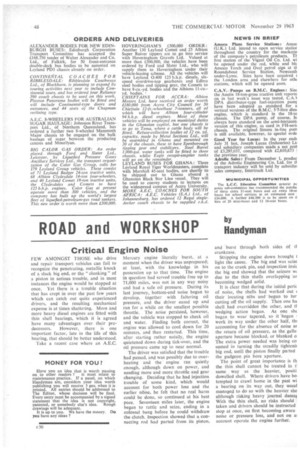ROAD and WORKSHOP. Y
Page 50

If you've noticed an error in this article please click here to report it so we can fix it.
Fl.ndyman
Critical Engine Noise
FEW AMONGST THOSE who drive and repair transport vehicles can fail to recognize the penetrating, metallic knock of a slack big end, or the " clonking " of a piston in serious trouble, and in most instances the engine would be stopped at once. Yet there is a trouble situation that has crept in over the past few years which can catch out quite experienced drivers, and the resulting mechanical expense is at times shattering. More and more heavy diesel engines are fitted with thin shell bearings, which it is agreed have many advantages over their predecessors. However, there is one important factor, late in the life of this bearing, that should be better understood.
Take a recent case where an A.E.C.
Mercury engine literally burst,, at a moment when the driver was unprepared; at least, with the knowledge in his possession up to that time. The engine in question had served trouble free up to 71,000 miles, was not in any way noisy and had a safe oil pressure. During its last journey, bottom-end noise began to develop, together with faltering oil pressure, and the driver eased up and ran for a while on the smallest possible throttle. The noise persisted, however, and the vehicle was stopped to check oil and water. Finding both correct, the engine was allowed to cool down for 20 minutes, and then restarted. This time, after starting rather noisily, the engine quietened down during tick-over, and the oil pressure came up to near normal.
The driver was satisfied that the trouble had passed, and was possibly due to overheating and the engine ran quietly enough, although down on power, and needing. more and more throttle and gear changing. Deciding that he had injection trouble of some kind, which would account for both power loss and the earlier nbise, he felt that no real harm could be done, so continued at his best pace. Seventeen miles later, the engine began to rattle and seize, ending in a colossal bang before he could withdraw the clutch. Inspection showed that a connecting rod had parted from its piston, and burst through both sides of t1 crankcase.
Stripping the engine down brought I light the cause. The big end was seize on to the crank pin, and inspection insic the big end showed that the seizure wz due to the thin shells overlapping ar becoming wedged solid.
It is clear that during the initial perk of noise, the shells had worked out 4 their locating nibs and' begun to tur cutting off the oil supply. Then one ha shell had overridden the other, and ti wedging action began. As one shc began to wear tapered, so it 'began work its way under the other half, thi accounting for the absence of noise at the return of oil pressure, as the galle aperture became blocked, or blanked o The extra power needed was being co sumed in turning the steadily tightenit big end, until the piston finally parted the gudgeon pin bore aperture.
The point of great importance is th the thin shell cannot be treated in f same way as the heavier, positi dowelled shell. Where drivers have be' tempted to crawl home in the past wi a bearing on its way out, they usual managed to do so with the heavier she although risking heavy journal damai With the thin shell, no risks should taken and drivers should be instructed stop at once, on first becoming aware noise or pressure loss, and not on a] account operate the engine further.








































































































